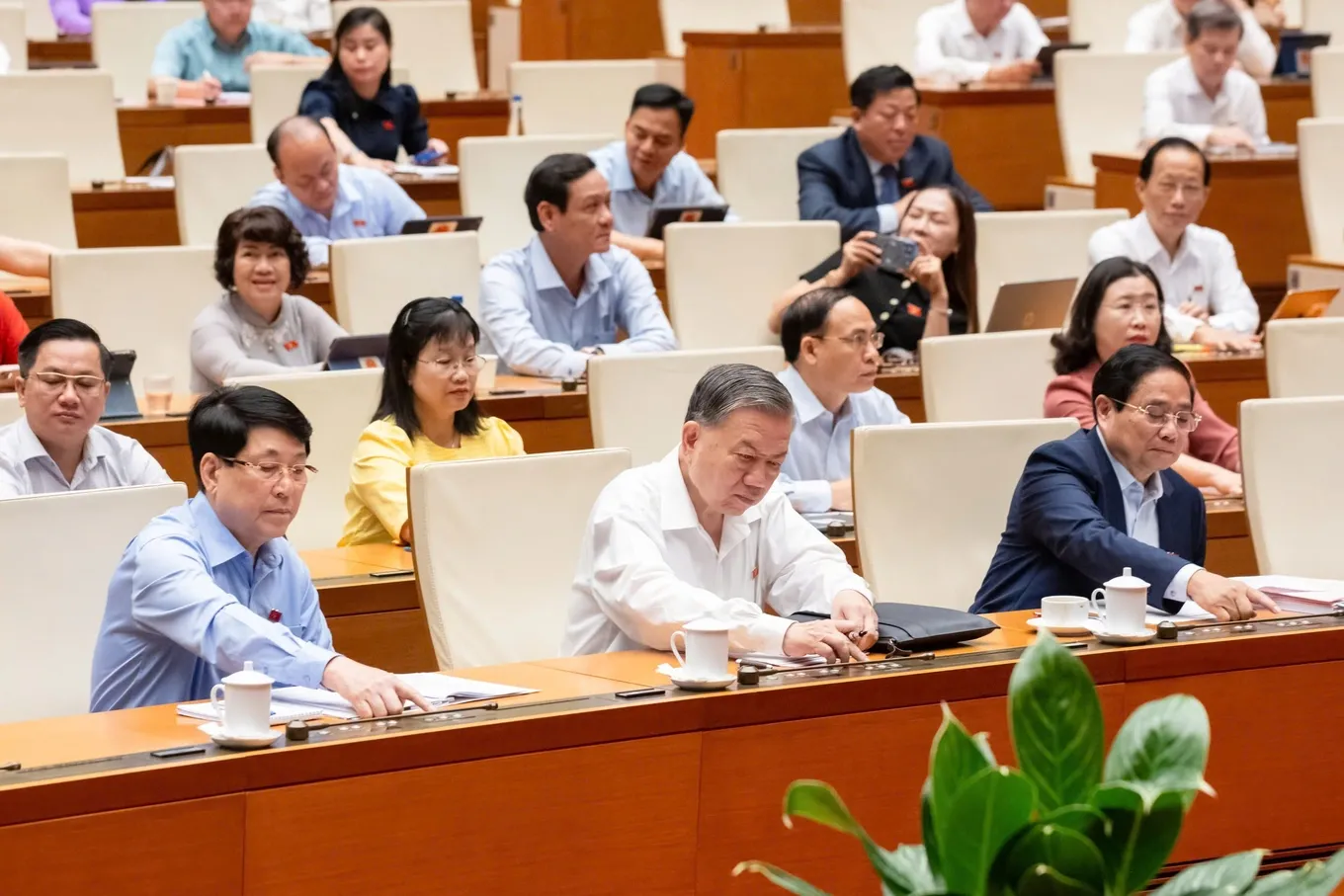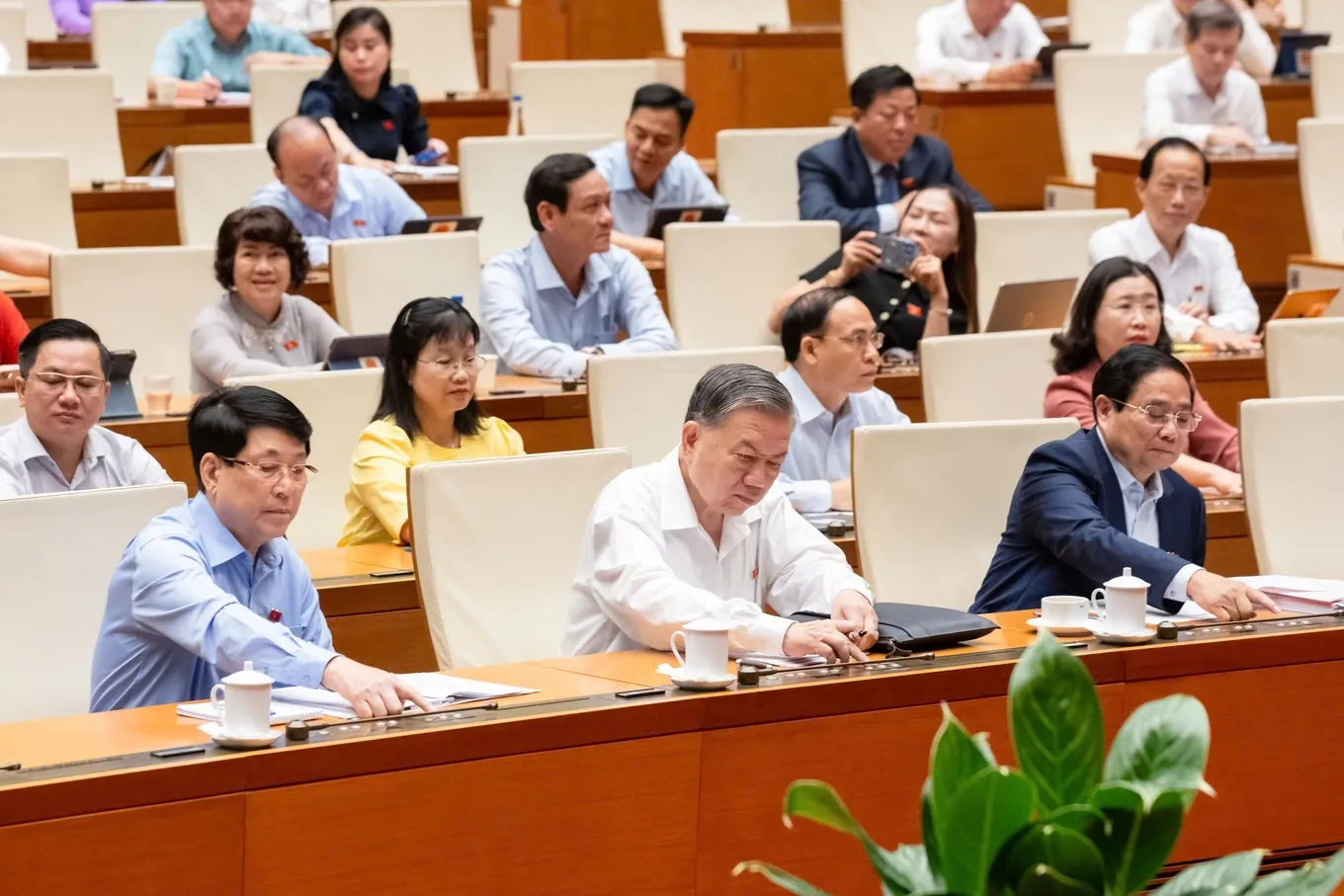
Bảo Khánh wrote this Vietnamese article, published in Luật Khoa Magazine on June 16, 2025.
On the morning of June 16, 2025, Việt Nam’s National Assembly passed a resolution amending the 2013 Constitution, concluding a historically swift revision. Here are the key highlights.
The Fastest Amendment in Vietnam’s History
Revising a constitution is a foundational legal process that usually unfolds over several years. Việt Nam’s last constitutional revision, for example, spanned from August 2011 to November 2013.
The 2025 amendment shattered this precedent. It began with Conclusion 127, a directive issued on February 28 by the Politburo and Secretariat that set a June 30 deadline for a review of Party regulations, the 2013 Constitution, and state laws. This kicked off a legislative sprint:
- May 5: The National Assembly passed Resolutions No. 194 and 195 to amend the Constitution and to establish a Drafting Committee.
- June 16: After a stunningly short period of one month and 12 days, the National Assembly passed the final amendment with a unanimous vote from all 470 delegates.
The resolution took effect immediately, marking a record-setting 43-day revision process.
What Was Amended in the 2013 Constitution?
The following constitutional articles were revised:
Table: 2013 Constitution vs 2025 Amendment
|
Article |
2013 Constitution |
2025 Amendment |
|
Article 9 |
The Việt NamFatherland Front (VFF) is a political alliance and voluntary union of political, socio-political, social organizations, and prominent individuals across classes, ethnicities, religions, and overseas Vietnamese. The VFF is the political base of the people’s government; represents and protects the legitimate rights and interests of the people; promotes national unity, democracy, social consensus; and participates in building the Party and the State. |
The VFF is now explicitly defined as part of the political system led by the Communist Party. It expresses the will and aspirations of the people and plays a broader role in supervising, giving feedback, and representing the public in relations with the State. Mass organizations are now officially subordinated to the VFF. |
|
Article 10 |
The Việt Nam Trade Union is a socio-political organization of the working class and laborers, formed voluntarily to represent, care for, and protect their legal rights and interests; participates in state management and socio-economic management; supervises related bodies and units; and educates workers in law and skills. |
Trade Unions are declared the sole national representative of labor in both domestic and international labor relations, with added emphasis on representing union members and workers and coordinating under the VFF. |
|
Article 84 (Clause 1) |
The President, National Assembly Standing Committee, Ethnic Council, Committees of the National Assembly, Government, Supreme People’s Court, Supreme People’s Procuracy, State Audit, Central Committee of the VFF, and central organs of member organizations of the Front have the right to propose draft laws and ordinances. |
Only central socio-political organizations (excluding other Front-affiliated member organizations) are now granted legislative initiative rights. |
|
Article 110 |
Administrative units are structured into provinces, centrally-run cities; provinces into districts, towns, provincial cities; cities into urban districts, districts, towns; districts into communes, townships; and special administrative-economic units established by the National Assembly. Boundary changes require public consultation. |
Administrative units are now structured into only two levels: provinces/cities and their subunits. Special units are still under the National Assembly. Boundary changes still require public consultation but under National Assembly procedures. |
|
Article 111 |
Local governments are established in administrative units, composed of People’s Councils and People’s Committees suited to rural, urban, island, and special units as stipulated by law. |
Local governments now exist at the two levels defined above. For special zones, organization is determined upon establishment by the National Assembly. Terminology adjusted to clarify that “local government” does not imply a uniform structure across all levels. |
Additionally, on July 1, all district-level administrative units across Vietnam will be dissolved, and no elections will be held for new local councils. Under this new structure, key leadership positions will be filled by appointment rather than by vote, including Chairpersons and Vice Chairpersons of People’s Councils (HĐND), heads of committees, and members of People’s Committees (UBND). The authority for these appointments is delineated:
- The National Assembly Standing Committee will appoint HĐND leadership and the heads of the National Assembly delegations.
- The Prime Minister will appoint UBND leaders.
- Provincial HĐND leadership will appoint district officials.
Non-elected individuals may be appointed to temporary leadership positions in special cases to ensure stability during the transition.
Key Issues of Public Concern
Resolution 194 emphasized streamlining government units, especially the Vietnam Fatherland Front (VFF), political-social organizations, and administrative units.
During public consultation, these issues drew the most attention:
- The consolidation of Mass Organizations under the VFF (Articles 9 & 10)
- Debates over sub-provincial administrative models (Article 110)
- Requiring public consultation for boundary changes (Article 110(2))
- Preserving local delegates’ right to question judges and prosecutors.(Article 115(2))
The proposed consolidation under the VFF generated over 37 million public responses. The issue of judicial accountability was also strongly contested by MPs and legal experts, with Delegate Nguyễn Thị Kim Thúy asking, “If wrongful convictions happen, who will question the judiciary on behalf of the people?”
Furthermore, many legal scholars formally objected to naming specific organizations like the VFF in the Constitution, arguing that it undermines the document’s generality and flexibility.
The Politburo’s Dominant Role
From the beginning, the amendment process was driven and controlled by the Communist Party’s Politburo. The February 28 mandate, Conclusion 127, outlined a six-step reform plan that positioned the constitutional amendment as the final, decisive outcome.
While a formal public consultation period was held in May, the process remained tightly managed. The Ministry of Justice reported receiving 280 million public responses, citing a near-unanimous 99.75% approval rate. Following this period, the government’s final proposed revisions included:
- Granting legislative proposal rights to central political-social organizations
- Preserving public consultation for local boundary changes (Article 110)
- Clarifying local government structures and terminology (Articles 111–114)
- Retaining the right of local delegates to question the judiciary (Article 115(2))
After a historic 43-day sprint, Việt Nam’s revised constitution was passed in June 2025.

